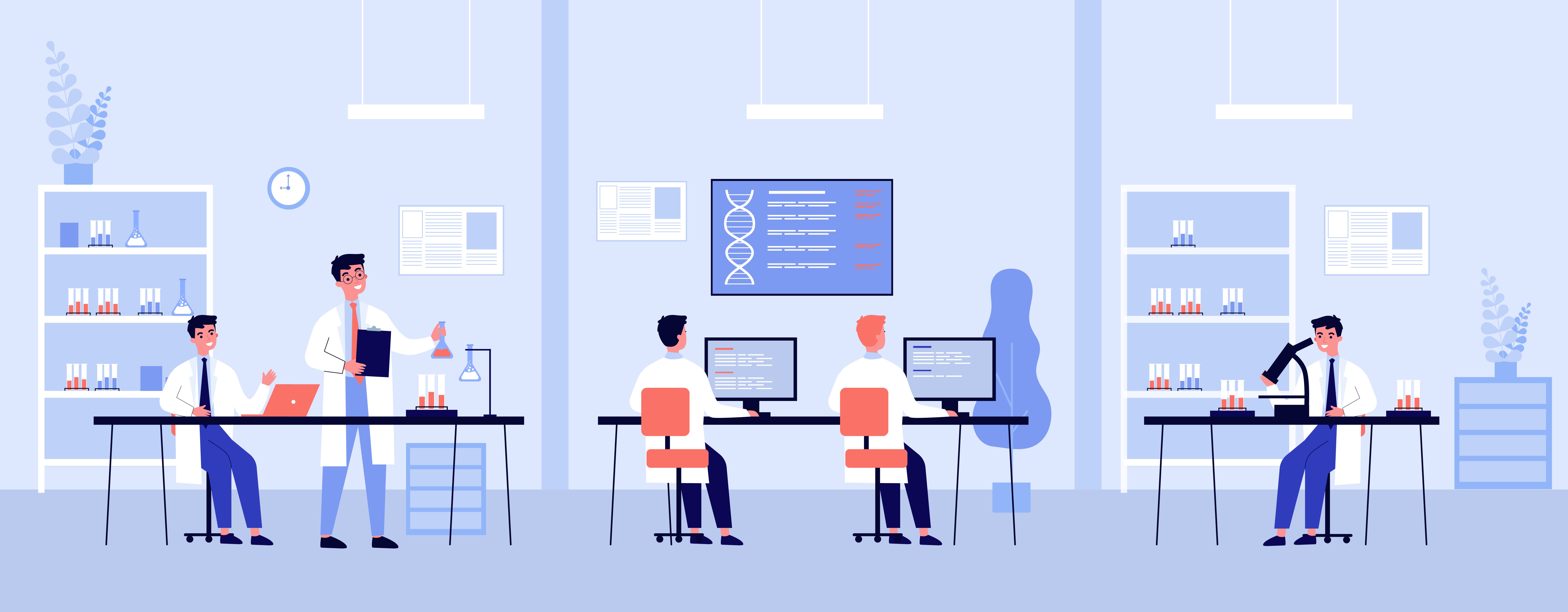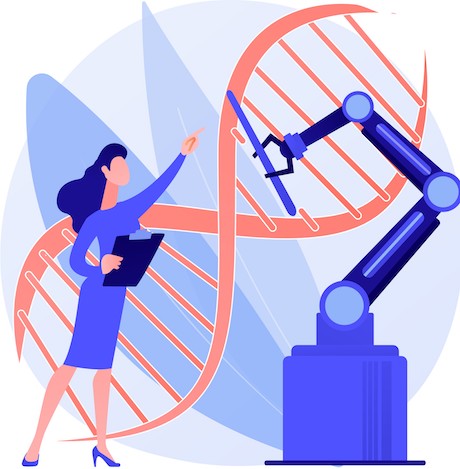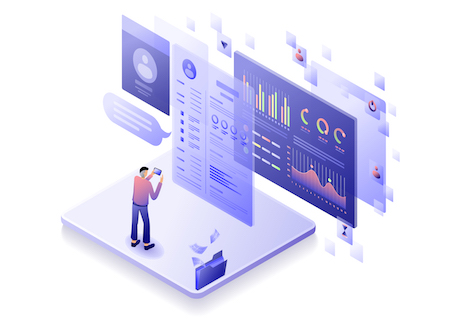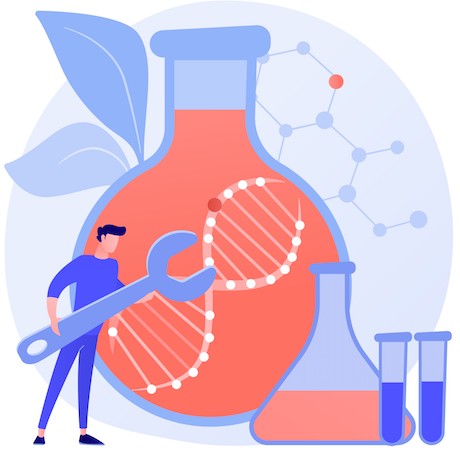
By Dr. Brandon Colby MD, a physician-expert in the fields of Genomics and Personalized Preventive Medicine.
DNA — short for deoxyribonucleic acid — is the molecule that contains all the genetic information of a living organism. DNA is made up of smaller molecules called nucleotides; each nucleotide contains a nitrogenous base, which can be adenosine, cytosine, guanine, and thymine.1
Single strands of nucleotides are bound together by their nitrogenous bases, forming base pairs and creating the DNA double helix model that we all recognize. The sequence in which these base pairs are organized is unique to each living being, and it directs all the functions that happen inside an organism in order to maintain its functions.
There are portions of your DNA that contain specific instructions for your cells to synthesize different proteins — these sections of coding DNA are your genes. Protein-coding regions in your DNA are called exons, and the sum of these exons make up your exome. Human beings usually inherit different variants — or alleles — of each gene from their parents.2 The genetic material you inherited is called your genotype, whereas the traits you actually exhibit are called your phenotype.
Your DNA contains information outside of its coding regions, too. The functions of non-coding DNA aren’t fully understood, but we know that they help regulate the process of DNA replication.
What It Means to Have Your Genome Sequenced
Your entire genome is the sum of all the DNA in your body, both coding and non-coding. It contains every bit of information regarding your traits, health, genetic data, and ancestry.
Whole-genome sequencing is a genomics process that determines the sequence in which all the base pairs in your DNA are arranged. A small sample of blood, saliva, or tissue is required to perform this groundbreaking test. Then, the DNA in your sample is broken down into smaller fragments which are analyzed by a special machine, called a sequencer.
The human genome contains approximately 3 billion base pairs, so it’s no wonder that it needs to be broken down in order to be properly analyzed.
The Use of Whole Genome Sequencing

Whole-genome sequencing has many uses in different fields, ranging from personalized medicine to general wellness. The information contained in your genome can be used to identify if you carry genetic conditions or rare diseases.
What is a genetic disease? In the case of autosomal or sex-linked recessive disorders3 — meaning that one person must inherit mutated genes from both their parents in order to develop the disease —, this information can be used to determine whether you could pass a condition on to your children, even if you don’t have it yourself. Recessive diseases include sickle cell anemia, hemophilia, cystic fibrosis, Gaucher’s disease, and Tay-Sachs disease, among others.
Dominant genetic diseases can also be tested — these diseases have a significant impact on the health of entire families and communities, and they include conditions such as Huntington’s disease, Brugada syndrome, certain vascular malformations, neurofibromatosis type 1, Marfan syndrome, familial hypercholesterolemia, and Gardner’s syndrome, amongst many others. Certain conditions that cause heart arrhythmias, such as Long QT syndrome, can be either dominant or recessive, depending on their type.
Genetic testing for diseases can identify your susceptibility to multifactorial diseases that are caused by a combination of genetic predisposition and lifestyle or environmental factors. Multifactorial diseases don’t have a clear-cut inheritance pattern and they include common health conditions that affect a significant percentage of the world’s population4, such as:
- Hypertension or high blood pressure
- Diabetes mellitus
- Coronary heart disease
- Chronic respiratory diseases
- Multiple sclerosis
- Asthma
- Obesity
- Alzheimer’s disease
- Parkinson’s disease
- Crohn's disease
- Epilepsy
- Autism spectrum disorder (ASD)
- Autoimmune diseases
Genetics can also play a role in the development of certain types of cancer. The BRCA1 and BRCA2 genes function as tumor suppressor genes; however, mutations in these genes can lead to a significant risk of developing breast cancer, ovarian cancer, colon cancer, prostate cancer, stomach cancer, pancreatic cancer, and a type of skin cancer called melanoma. WGS can detect BRCA mutations to alert you of these risks. You can learn more about genetic testing for breast cancer if you're interested in knowing about your risk.
There are many other processes in your body that can become dysregulated as a result of pathogenic variants — for example, your response to medications is mediated by genes such as CYP2D6, which regulates part of the cytochrome p450 complex that helps metabolize medications.
Your immune function is also partly modulated by genetics, through substances such as human leukocyte antigens (HLA) genes and the major histocompatibility complex (MHC). WGS can identify abnormalities in these and many other systems in your body.
You can also use WGS to discover more about your genetic genealogy. To achieve this, your genetic data will be compared to databases from different ethnic populations to identify the presence of variants that are characteristic of each ethnicity. In fact, your DNA can even be matched to ancient DNA from archeological sites.
WGS isn’t only applicable to human DNA. The DNA of different microorganisms can also be sequenced, such as viruses and bacteria — thus, WGS can even be used to better understand the spread of infectious diseases, their origin, and how to prevent them.
The Benefits of Whole Genome Sequencing

The importance of whole genome sequencing cannot be ignored. The following are the benefits of it:
- WGS detects genetic variants that increase your predisposition to preventable diseases, it will help you make better lifestyle choices in order to decrease your risk of actually developing these diseases. Other applications of genomics, such as personalized wellness and nutrigenomics, can be used to help you develop healthier habits that are specific to your own health risks.
- Genomics and WGS have also revolutionized the care of genetic or Mendelian disorders.5 Just a few years ago, it was often very difficult to achieve an accurate genetic diagnosis — especially for uncommon diseases that aren’t fully understood. Gene sequencing has made it possible for researchers to identify the exact somatic mutation that causes each type of genetic disorder, even in the case of rare diseases or orphan diseases that haven’t been properly studied yet.
- Thanks to pharmacogenomics, your physician will know exactly which medications work best for you, and you won’t have to risk adverse effects. Through precision medicine, you’ll also have to wait less time for an accurate diagnosis. For patients who have a disease that doctors cannot diagnose, WGS can guide clinicians to the correct treatment.
- WGS results can also be used to help you and your partner have a healthy baby; this can be particularly helpful for prospective parents who are dealing with fertility issues or who have family members with genetic disorders. WGS is already used in pediatrics to treat children with difficult-to-diagnose diseases.
- Personalized medicine and WGS will also play a significant role in the future of public health. Even as you read this, different countries — such as the UK, France, and Australia 6 — are implementing strategies with the aim of providing free DNA sequencing through their healthcare systems.
Why Whole Genome Sequencing Is Better Than Other DNA Tests
Whereas other types of tests, such as whole exome sequencing, single-gene testing, and single nucleotide polymorphism (SNP) genotyping can be helpful to diagnose mutations that affect a single gene or chromosome, but they won’t provide a base-by-base overview of your DNA.
These sequencing methods can detect many different ailments, but they can also miss vital genetic information. Tests that are more targeted can be very useful when you need to detect structural variations in a specific gene, but they can leave out many other variants.
Differences Between WGS and Tests from 23andMe and Ancestry.com
While whole genome testing is able to map out your entire DNA — regardless of whether it’s coding or non-coding regions—, many commercial tests offered by popular companies like 23andMe and Ancestry.com, don’t provide the same depth of information.
23andMe uses a technology known as DNA genotyping, which simply identifies the presence of specific genetic variants in your DNA. But since it doesn’t analyze your entire genome, these variants of interest must be pinned down before the test is carried out.
Ancestry.com, on the other hand, uses autosomal DNA testing. This type of genetic testing analyzes the majority of your chromosomes but it only looks for specific SNPs which only make up a small portion of all the genetic variants that may exist in your DNA.
Whole Genome Sequencing Methods
The first methods used for genomic sequencing were manual, such as Sanger sequencing and Maxam-Gilbert sequencing. These techniques were expensive and extremely time-consuming. Other techniques, such as DNA chips or microarrays7 have also been used to sequence the DNA or RNA of different genomic regions.
New techniques, commonly known as next-generation sequencing (NGS) or high-throughput sequencing technologies reduced sequencing costs and accelerated the workflow of genetic testing. DNA sequencing techniques include large-scale, de novo, shotgun, and high-throughput sequencing, among others.8 Several modern DNA sequencing methods are currently available or in development, including:
- Illumina dye sequencing
- Pyrosequencing
- Ion Torrent sequencing
- Single-molecule real-time (SMRT) sequencing
- Sequencing by ligation (SOLiD sequencing)
- Nanopore sequencing
Whole Genome Sequencing Analysis

Once your DNA has been sequenced, the resulting sequencing data is analyzed using bioinformatics technology. Annotations are made in order to identify each gene and any possible genetic variations, and the sequence data is compared to different genetic databases.
These methodologies allow for the identification of structural variants such as SNPs, single nucleotide variants (SNVs), point mutations, and mitochondrial heteroplasmy9, among other variations. Analyzing a genetic dataset to understand the structure of the DNA can be used to predict how genes and proteins will behave in an organism; this information can then be used to determine the genetic cause of many illnesses, and also to find genealogic similarities to specific population groups.
Just as different sequencers can be used for genetic testing, different methodologies can also be used to perform sequence analysis10. These methods include cDNA microarray, qPCR, Northern Blot, methylation-dependent restriction enzymes (MDRE), chromatin immunoprecipitation (ChIP), mass spectrometry (MS), two-dimensional gel electrophoresis (2- DE), among others. In some cases, several methodologies can be combined for a more comprehensive analysis.
Whole genome sequencing analysis shouldn’t be confused with DNA analysis or profiling, which is a simpler method meant to identify an individual without sequencing their DNA. DNA profiling is often used in forensics to determine the likelihood that someone committed a crime; it’s also used in parentage testing.
The Difference Between Testing, Analysis, and Reporting
Testing, analysis, and reporting are different steps that must be carried out properly in order to generate high-quality genetic testing results. Although they’re all part of the same process, they’re not the same.
- Testing is the first step of the WGS process; the DNA in your sample will be broken down into smaller fragments and sequenced. Keep in mind that not all genetic testing is WGS — other types of genetic testing are available, but they won’t deliver the same amount of information.
- Analysis allows your DNA sequence to be compared to others in order to identify findings that are relevant to your ancestry and different aspects of your health. Genome analysis is also vital for the creation of extensive genetic databases that can be used to identify and study genetic mutations and diseases.
- Reporting is the final step of the process, in which raw data is used to create a genetic report11 containing all the pertinent information that was found as part of your WGS. Reports can be tailored for patients or healthcare professionals, depending on the specific case and who will be reviewing the information.
Why Bioinformatics Analysis Is Important
99.9 percent of the human genome is identical for everyone, so it’s incredibly important to perform a high-quality analysis of that remaining 0.1 percent in order to find the variants that determine our ethnicity, genetic risks, and health.
Genetic variants are identified during the sequencing process, but it’s only through sequence analysis that we can understand their meaning and how they may impact a specific individual. But genome analysis isn’t only useful for individual purposes — as more genomes are analyzed around the world, genetic databases become more comprehensive and the significance of newly discovered variants can finally be understood.
Sequence analysis of large-scale genomics projects could help scientists identify unknown genetic disorders and develop effective methods to prevent, diagnose, and treat them in the future. This process helps fill in significant gaps in our knowledge about genetics, disease pathways, and human health.
Not All DNA Analysis Is The Same
Raw genetic data contains a massive amount of information that needs to be analyzed in order to be fully understood — thus, it’s important to ensure that you seek a genetic testing provider that is able to perform a thorough analysis of your DNA sequence in order to deliver comprehensive results.
Not All DNA Reporting Is The Same
Great DNA reports won’t just identify relevant variants; instead, they’ll also explain their significance and the impact that they can have on your life. There are different types of reports available, and they can contain information regarding different areas of your life.
What does a DNA report look like? Poorly-generated genetic reports tend to be lengthy and complicated, but they may not offer useful and actionable information. A good genetic report will be easy to understand, and it should include advice that will make it easier for you to make decisions concerning your results.
DNA Sequencing Companies Offer Different Analysis and Reporting
Human error and poor techniques can result in untrustworthy, low-quality genetic test results. When it comes to testing your DNA, you should choose a company that has a respectable trajectory in the field of genomics to ensure the quality of your results.
Other companies, on the other hand, offer accurate but limited results. Some companies focus solely on ancestry testing, whereas others concentrate on specific health insights. As a result, your raw genetic data may be underutilized and you won’t receive all the potential information that you could benefit from.
What is Clinical-Grade Whole Genome Sequencing?
Clinical-grade WGS means that the sequencing process was thorough enough to provide results that can be used for health-related purposes — such as disease diagnosing, genetic counseling, and making treatment decisions12.
For WGS results to be considered clinical-grade, they must have 30x coverage. 30x whole genome sequencing means that the sequencer used sequenced your genome 30 times. This increases the accuracy of your results by ensuring that every portion of your DNA is sequenced enough times to identify all possible variants.
What To Consider Before Having Your Genome Sequenced
When it comes to having your DNA sequence analyzed and uploaded, it’s important to research different providers to ensure that you’ll get a high-quality service and that your information will remain secure and confidential.
As stated above, you should keep in mind that not all genetic testing providers use whole genome sequencing — look for providers that specify the type of WGS that they offer, the DNA apps that you’ll be able to access to explore your results, and whether they provide counseling from genetics specialists.
WGS can reveal a treasure trove of useful information that can be relevant to your health and inform the decisions that you make every day. But not all genetic variants are pathogenic — some variants don’t affect your health at all, whereas the significance of other variants is still unknown.
In order to optimize your genetic test results, it’s vital to review them with the help of a geneticist or specialist. This way, you’ll get to make informed choices regarding your health and lifestyle while avoiding unnecessary stress over genetic variations that you don’t need to worry about.
How To Understand Your Genome

Once you get your WGS results, the amount of information they contain can be overwhelming. Thankfully, DNA apps, reports, and tools such as Genome Explorer can all be used to provide useful insights regarding your genetic results.
DNA Apps Analyze Your Genome
The DNA App Store contains dozens of different apps that can be used to analyze your genetic tests results and provide actionable, evidence-based insights that will allow you to make healthier decisions and understand yourself much better.
Our apps can tell you anything you’d possibly want to discover about yourself — from longevity reports to relative matching, and even COVID-19 outcome reports because coronavirus and DNA go hand-in-hand.
Genome Explorer Is A Search Engine For Your DNA
Genome Explorer functions as an online browser where you can upload your raw genetic data to quickly find how out it impacts your health and its association to different traits, diseases, and even your reaction to medications.
To use Genome Explorer, you can either upload raw DNA data obtained from other services or order your own genetic test and discover the significance of the variations present in your DNA.
How To Get Free DNA Reports
If you have raw DNA data provided by a genealogy testing service, you can use platforms such as Sequencing to generate free genetic reports to get the most out of your genetic data. Sequencing.com provides numerous types of DNA reports and apps, including health, wellness, nutrition, ancestry, fitness, and even lifestyle.
Learn more about Sequencing.com free DNA reports here or learn about whole genome sequencing cost.
The Best Whole Genome Sequencing
At Sequencing.com, we offer high-quality 30x clinical-grade whole-genome sequencing. The test simply requires a mouth swab sample, and the kit can be ordered and used from the comfort of your own home. You’ll receive your results in about 8 weeks.
Use our Ultimate Genome Sequencing test to discover Single Nucleotide Polymorphisms (SNPs), Insertions and Deletions (INDELs), Structural Variations (SVs), Copy Number Variations (CNVs), and Mitochondrial Heteroplasmy (MITO) in your DNA. Our online licensed genetic counselors are available to answer any questions you may have regarding your test results.
But that’s not all — through Sequencing.com, you can also gain access to over 100 DNA data analysis apps that provide evidence-based genetic insights on your health, ancestry, and lifestyle. In fact, you can use these apps to upload test data from other providers for more comprehensive results. Our service is secure and confidential, and we protect your genetic data through advanced encryption techniques.
Discover the services we offer here and visit our Education Center to learn more about genomics.
References
- DNA. (n.d.). Genome News Network. Retrieved December 23, 2020, from http://www.genomenewsnetwork.org/resources/whats_a_genome/Chp1_4_1.shtml#:~:text=DNA%20is%20the%20molecule%20that,material%20in%20all%20living%20cells.&text=A%20gene%20consists%20of%20enough,total%20of%20an%20organism's%20DNA
- What are variants, alleles and haplotypes? (n.d.). EMBL-EBI Training. Retrieved December 23, 2020, from https://www.ebi.ac.uk/training-beta/online/courses/human-genetic-variation-introduction/what-is-genetic-variation/what-are-variants-alleles-and-haplotypes/
- Autosomal recessive inheritance pattern. (n.d.). Mayo Clinic. Retrieved December 22, 2020, from https://www.mayoclinic.org/autosomal-recessive-inheritance-pattern/img-20007457
- What are complex or multifactorial disorders? (n.d.). MedlinePlus. Retrieved December 22, 2020, from https://medlineplus.gov/genetics/understanding/mutationsanddisorders/complexdisorders/
- Chakravarti A. (2011). Genomic contributions to Mendelian disease. Genome research, 21(5), 643–644. https://doi.org/10.1101/gr.123554.111
- Stark, Z., Dolman, L., Manolio, T. A., Ozenberger, B., Hill, S. L., Caulfied, M. J., Levy, Y., Glazer, D., Wilson, J., Lawler, M., Boughtwood, T., Braithwaite, J., Goodhand, P., Birney, E., & North, K. N. (2019). Integrating Genomics into Healthcare: A Global Responsibility. American journal of human genetics, 104(1), 13–20. https://doi.org/10.1016/j.ajhg.2018.11.014
- Bumgarner R. (2013). Overview of DNA microarrays: types, applications, and their future. Current protocols in molecular biology, Chapter 22, Unit–22.1.. https://doi.org/10.1002/0471142727.mb2201s101
- Pettersson E., Lundeberg J., Ahmadian A. (February 2009). Generations of sequencing technologies. Genomics. 93 (2): 105–11. doi:10.1016/j.ygeno.2008.10.003
- Santibanez-Koref, M., Griffin, H., Turnbull, D. M., Chinnery, P. F., Herbert, M., & Hudson, G. (2019). Assessing mitochondrial heteroplasmy using next-generation sequencing: A note of caution. Mitochondrion, 46, 302–306. https://doi.org/10.1016/j.mito.2018.08.003
- Gasperskaja E, Kučinskas V. The most common technologies and tools for functional genome analysis. Acta Med Litu. 2017;24(1):1-11. https://doi.org/10.6001/actamedica.v24i1.3457
- General Genomic Reporting. (2018, December 4). HL7 International Clinical Genomics Work Group. Retrieved December 23, 2020, from http://www.hl7.org/fhir/uv/genomics-reporting/2019Jan/general.html
- Shevchenko, Y., & Bale, S. (2016). Clinical Versus Research Sequencing. Cold Spring Harbor perspectives in medicine, 6(11), a025809. https://doi.org/10.1101/cshperspect.a025809
About The Author
Dr. Brandon Colby MD is a US physician specializing in the personalized prevention of disease through the use of genomic technologies. He's an expert in genetic testing, genetic analysis, and precision medicine. Dr. Colby is also the Founder of Sequencing.com and the author of Outsmart Your Genes.
Dr. Colby holds an MD from the Mount Sinai School of Medicine, an MBA from Stanford University's Graduate School of Business, and a degree in Genetics with Honors from the University of Michigan. He is an Affiliate Specialist of the American College of Medical Genetics and Genomics (ACMG), an Associate of the American College of Preventive Medicine (ACPM), and a member of the National Society of Genetic Counselors (NSGC).